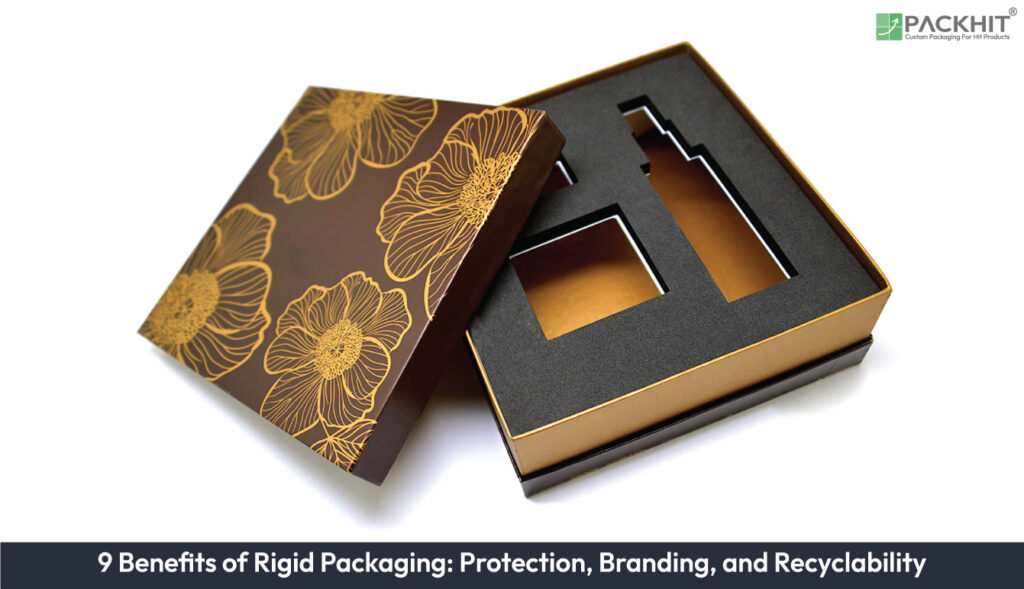Rigid packaging offers a wide range of benefits that enhance both functionality and consumer experience. Its durable protective strength and robust structural integrity safeguard fragile and high-value items during transit and storage. These features contribute to superior product safeguarding, preserving quality, and minimizing damage. Businesses can leverage customizable brand identity options like embossing and foil stamping to create a distinct market presence. Additionally, the elevated unboxing experience provided by rigid packaging enhances consumer satisfaction and brand loyalty. With recyclable materials and eco-friendly material innovations, it supports sustainability goals while maintaining a premium appeal. The packaging’s strength also ensures reduced product waste and optimized storage efficiency, offering practical advantages in logistics and inventory management.
9 benefits of rigid packaging are listed below:
- Durable Protective Strength
- Robust Structural Integrity
- Enhanced Product Presentation
- Customizable Brand Identity
- Elevated Unboxing Experience
- Recyclable Materials
- Reduced Product Waste
- Eco-Friendly Material Innovations
- Optimized Storage Efficiency
1. Durable Protective Strength
Rigid packaging is meticulously crafted using robust materials such as thick paperboard or corrugated cardboard, offering durability and protective strength against external forces. This structural integrity ensures products remain secure during transit and storage, minimizing the risk of damage to fragile or high-value items. For manufacturers, this reliability translates into reduced losses and enhanced product quality preservation, making rigid packaging an indispensable choice where protection is paramount.
2. Robust Structural Integrity
The composition of rigid packaging offers robust structural integrity, superior impact resistance, and load-bearing capacity, making it ideal for industries where product protection is critical, such as electronics and luxury goods. Unlike flexible packaging alternatives, rigid packaging retains its shape under stress, preventing deformation and ensuring secure containment of items with precise dimensions, such as medical devices or premium electronics. This consistency in form and function provides manufacturers with a reliable solution tailored to meet stringent product safety requirements.
3. Enhanced Product Presentation
Rigid packaging provides enhanced product protection, elevating the visual and tactile appeal of rigid packaging and minimizing risks during transit, handling, and storage. The reinforced structure ensures items are protected from external forces, maintaining their quality and integrity, particularly for delicate or high-value goods. Its premium finish, achieved through techniques like offset printing, embossing, and foil stamping, enhances the perceived value of the product. By combining protection with aesthetics, rigid packaging transforms products into premium offerings that meet both functional and branding expectations.
4. Customizable Brand Identity
Rigid packaging provides extensive customization options for businesses to align their packaging with specific brand attributes. Techniques such as embossing, debossing, foil stamping, and spot UV coating allow brands to create intricate designs that convey exclusivity and attention to detail. For instance, luxury watchmakers often employ rigid boxes with premium textures and metallic accents to reinforce their high-end positioning. Rigid packaging supports precise color matching and logo placement, ensuring consistency across product lines and enhancing brand recognition in competitive markets.
5. Elevated Unboxing Experience
The rigid structure and premium finish of rigid packaging create a superior unboxing experience, which is increasingly recognized as a critical touchpoint in consumer engagement. Its sturdy design not only protects the contents but also delivers a sense of quality and care, leaving a lasting impression on customers. Features like magnetic closures, ribbon pulls, or layered compartments add an element of surprise and luxury, further enhancing the consumer’s perception of the product. This attention to detail fosters customer loyalty and sets brands apart in industries such as cosmetics, electronics, and luxury goods, where the unboxing ritual is a key driver of consumer satisfaction.
6. Recyclable Materials
Rigid packaging is predominantly made from materials such as thick paperboard and corrugated cardboard, both of which are recyclable and sourced from renewable resources. These materials can undergo multiple recycling cycles, significantly reducing landfill contributions and conserving natural resources. Many manufacturers are adopting FSC-certified paperboard, ensuring sustainable forestry practices. This alignment with eco-friendly packaging preferences not only meets regulatory requirements but also appeals to environmentally conscious consumers, making it a strategic choice for businesses aiming to enhance their sustainability profiles without compromising on quality or functionality.
7. Reduced Product Waste
The robust construction of rigid packaging helps reduce product waste and ensures superior protection for products, significantly reducing the risk of damage during transportation, handling, and storage. This durability directly contributes to waste reduction, as fewer products are discarded due to spoilage or breakage. For instance, in industries like food and beverages, rigid packaging helps maintain the freshness and quality of products, preventing unnecessary losses and supporting a more sustainable supply chain. Additionally, manufacturers benefit from increased efficiency and cost savings by minimizing product returns and replacements caused by inadequate packaging.
8. Eco-Friendly Material Innovations
Rigid packaging leverages eco-friendly material advancements, including biodegradable and compostable solutions enabled by cutting-edge material science. With the ability to naturally decompose, these materials significantly reduce environmental impact while maintaining the structural integrity required for product protection. Businesses adopting these innovations align with stringent environmental regulations and meet the expectations of eco-conscious consumers. Examples include packaging made from plant-based polymers and recycled paperboard, both of which lower carbon footprints and enhance brand reputation. This approach not only satisfies sustainability goals but also delivers high-quality, durable packaging solutions suitable for modern industries.
9. Optimized Storage Efficiency
Rigid packaging enhances storage efficiency through its stackable design and durable structure, which maximizes space utilization during transportation and warehousing. Unlike flexible packaging that may collapse under pressure, rigid packaging maintains its form, ensuring products are stored securely and uniformly. This organization reduces handling time and minimizes the risk of damage caused by improper stacking. For manufacturers, optimized storage translates into cost savings, streamlined logistics, and better inventory management, making rigid packaging a practical and functional choice for industries demanding reliable storage solutions.

